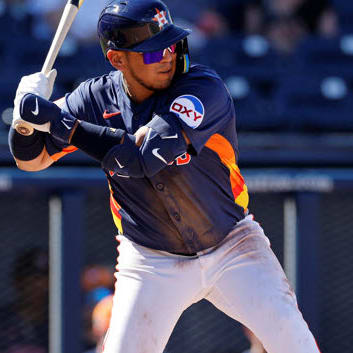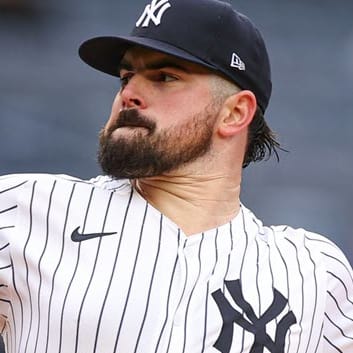This article is part of our The Saber's Edge series.
A simple, easily followed fantasy baseball axiom is start all hitters at Coors Field and bench all pitchers. The perceived high run-scoring environment in Coors is backed by numbers over the years. But is the line so delineated that all hitters should be started in Colorado and no pitcher should be used?This week we'll look at how much to adjust a player's production in Colorado and see if the above rule of thumb is true.
First, there was pre-humidor Coors when baseballs dried out and hardened, and subsequently flew out of the ballpark, thanks to mile-high Denver's dry climate. The Rockies knew this would be a park feature, so they made Coors a big park in hopes of limiting home runs. The large park wasn't enough, though, so the humidor was added in 2002 and offensive production dropped, especially home runs.
Fewer balls left the park, but since Coors was so large quite a few of those batted balls fell for hits. The way the park currently plays is mainly to increase BABIP with a decent percentage of those batted balls going for extra bases. Here is a look at how large the effect is, starting with hitters.
Effects on Hitting
Let's first look at how the Rockies performed at home and away from 2002 to 2015. Here are differences between the home and road (home minus road) stats:
| BABIP | AVG | OBP | SLG | ISO | HR/FB% |
| +0.046 | +.057 | +.058 | +.106 | +.049 | +3.2 |
One item to remember with Colorado batters is their full season projections will split the difference between home and road stats. A hitter projected for a .250 AVG will hit ~.222 on the road and ~.278 at home.
The difference is fairly significant. Take Charlie Blackmon, for example. We project him for .280/.336/.426 in 2016. By using the above average changes, he should hit .251/.307/.373 (e.g. Ryan Goins) on the road and .308/.365/.479 (e.g. Buster Posey) at home. Another example is Ben Paulsen, whom I drafted in Tout Wars. His .271/.320/.485 means he is almost unplayable on the road (.243/.291/.432), but at home, he becomes a .300/.349/.538 monster, which is similar to Paul Goldschmidt and Andrew McCutchen. I will gladly take advantage of Paulsen's home games.
Now, how do Colorado's opponents perform? I looked at overall and Colorado results for the Rockies' four NL West opponents the last three seasons. The actual splits, Coors vs. non-Coors numbers, could be a little wider because the Colorado numbers are included with the season stats. The differences need to use the full-season stats, which have a "Coors Effect" factored in, because player projections have it factored in also.
Here are the average and median differences (home minus road):
| BABIP | AVG | OBP | SLG | ISO | HR/BATTED BALL | |
| AVERAGE | +.039 | +.050 | +.039 | +.106 | +.057 | +.022 |
| MEDIAN | +.031 | +.043 | +.040 | +.098 | +.054 | +.021 |
As I said, not as much of a difference as the Rockies players, but still a significant change.
Here is the adjustment for Brandon Crawford. He is projected for .250/.309/.452, which is similar to Trevor Plouffe and Leonys Martin. With the changes, his slash line jumps (using median values) to .293/.349/.550, which puts him in the Josh Donaldson and J.D. Martinez level of production. He goes from a 20th-round talent to top-3 round.
With a 50-point bump in AVG and OBP and 100-point increase in SLG, a hitter needs to be projected near .200/.225/.275 to not be played in Colorado. Heck, using those pathetic numbers, the hitter becomes similar to Hector Olivera or Chase Utley. Depending on league depth, these two hitters may still be in play.
Now, in really shallow leagues, it may be that automatic starters need to sit if a bench player is in Colorado. Consider an outfield of Andrew McCutchen, Lorenzo Cain and Yoenis Cespedes. It seems insane to sit Cain or Cespedes, but an owner should bench those players for Ben Paulsen in Coors. They might not sit one for Jeff Francoeur, but if an owner has Francoeur on his roster he should not plan on winning anyway.
Only the very worst hitters should not be started in Colorado. Below-average hitters become above average. Average hitters become All-Stars, good hitters become MVPs.
Effects on Pitching
Well, the old adage of starting every hitter in Coors seems to be true. Now, it is time to look at pitchers. Colorado pitchers, while not great to begin with, were completely ignored in NL Tout Wars with Jonathan Gray going for $1 and Jorge De La Rosa and Chad Bettis going in the reserve rounds. Owners have little faith in Colorado pitchers.
Again, let's look at the differences in Colorado's home and road splits from 2002 to 2015.
| K/9 | BB/9 | HR/9 | WHIP | ERA | FIP |
| -0.2 | -0.5 | +0.2 | +0.04 | +0.47 | +0.12 |
These values lineup with the hitting stats with some small changes in plate discipline. Also, there is not a huge increase in home runs allowed. Instead, the big difference is the near half-run increase in ERA from batted balls. So for Rockies pitchers, the difference is only about a quarter of a run.
All Colorado starters are projected to have a 2016 ERA higher than 4.00, so in most leagues a quarter run improvement is just going to barely cut it to an ERA of 3.75. Pitchers with a projected 3.75 ERA are Daniel Norris, Hector Santiago and Kyle Gibson. I think I would take a chance on some non-Rockies with the talent for a 3.75 ERA and play them every week, as opposed to starting/benching Rockies pitchers based on home/road starts.
I also looked at how the Rockies' division opponents performed in Coors vs. the rest of the season. The numbers (home minus road) get a little weird here:
| K/9 | BB/9 | WHIP | ERA | |
| AVERAGE | -1.00 | 0.00 | +0.27 | +1.88 |
| MEDIAN | -0.85 | 0.00 | +0.26 | +1.88 |
Holy cow, what a difference compared to the change Colorado pitchers experience. I checked my numbers a few times and they kept coming out the same.
One explanation I thought of is that teams don't want their star pitchers throwing at Coors, so they adjust their rotations accordingly. The one reason I considered this is the large drop is strikeouts. To verify this explanation, I examined NL West pitchers who threw the most innings over the same period to see how they normally performed and then how they performed at Coors. Here are their results (home minus road):
| K/9 | WHIP | ERA | |
| AVERAGE | -0.86 | +0.24 | +1.27 |
| MEDIAN | -0.80 | +0.27 | +0.98 |
Well, there seems to be some truth to worse pitchers getting stuck with Colorado starts, but the entire difference is not explained. Searching the great and vast Internet, severaltheoriesareproffered for why this difference exists. After reading a few articles, the reason for the difference is just not 100 percent known, and for fantasy purposes, we don't really care.
What we do know is that the road pitcher should expect between a 1.00 and 2.00 increase in ERA. I might put the ERA drop near 1.50, but I could understand if owner wants to use a smaller or larger number. Additionally, I will put the K/9 drop near 0.9 and the WHIP increase at .25.
Using these numbers, let's look at how Clayton Kershaw is projected to perform in Coors. We have Kershaw pegged for a 1.95 ERA, 0.88 WHIP and 10.0 K/9 this season. The Coors adjustment gives him a 3.45 ERA, 1.15 WHIP and 9.1 K/9. Not a horrible pitcher. He is at the Garrett Richard and Yordano Ventura level.
But if non-aces pitch in Coors, the results get ugly. Take Ventura and his projected 3.46 ERA, 1.24 WHIP and 8.0 K/9. Those would morph into a 4.96 ERA, 1.49 WHIP and 7.1 K/9. Now we are in the Ricky Nolasco, Carlie Morton and Edwin Jackson range.
Conclusion
Generally, the statement to "start all hitters at Coors and bench all pitchers" is true. Only the league's worst hitters don't get enough of a boost to be relevant. One key is to make sure to put batters in Colorado over lineup regulars. Additionally, only the top handful of aces should get a Colorado start. Coors Field has its own unique scoring environment and should always be treated as such.












